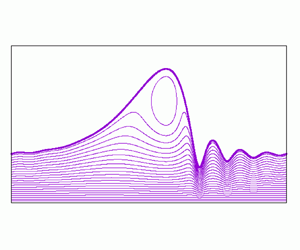Published online by Cambridge University Press: 29 November 2022

A new two-equation model for gravity-driven liquid film flow based on the long-wave expansion has been derived. The novelty of the model consists in using a base velocity profile combining parabolic (Ruyer-Quil & Manneville, Eur. Phys. J. B, vol. 15, issue 2, 2000, pp. 357–369) and ellipse (Usha et al., Phys. Fluids, vol. 32, issue 1, 2020, 013603) profile functions in the wall-normal coordinate. The dependence on a free parameter  $A$ related to the eccentricity of an ellipse serves as an adjustable parameter. The resulting models are consistent at
$A$ related to the eccentricity of an ellipse serves as an adjustable parameter. The resulting models are consistent at  $O(\varepsilon )$ for inertia terms and at
$O(\varepsilon )$ for inertia terms and at  $O(\varepsilon ^2)$ for viscous diffusion effects, and predict accurately the primary instability. Appropriate tuning of the adjustable parameter helps to recover accurate predictions for the asymptotic wave celerity of nonlinear solitary waves. Further, the model is shown to capture the closed separation vortices that can form underneath the troughs of precursory capillary ripples.
$O(\varepsilon ^2)$ for viscous diffusion effects, and predict accurately the primary instability. Appropriate tuning of the adjustable parameter helps to recover accurate predictions for the asymptotic wave celerity of nonlinear solitary waves. Further, the model is shown to capture the closed separation vortices that can form underneath the troughs of precursory capillary ripples.